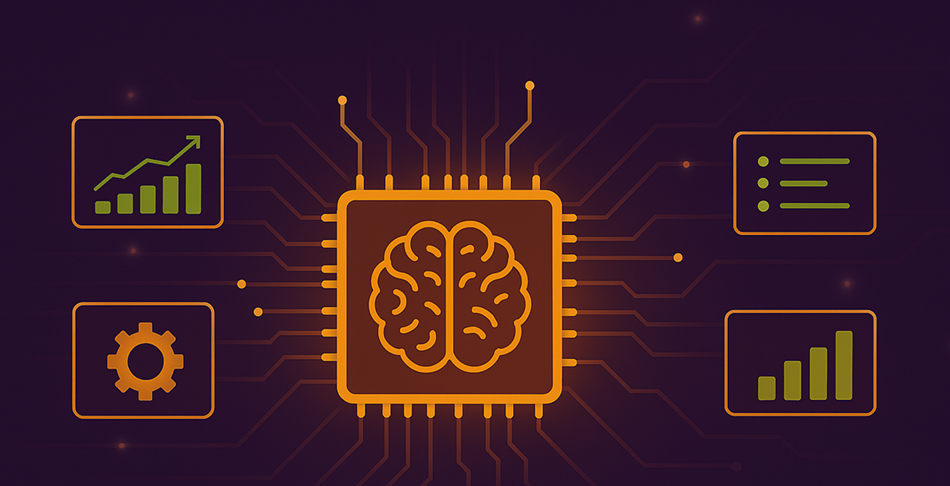Generative AI is redefining ERP systems — evolving from static systems of record into adaptive decision-making partners that learn, predict, and respond. From precise demand forecasting to instant financial reporting, generative AI is reshaping ERP across every layer of the enterprise.
The big players — Microsoft, SAP, Oracle — are already embedding AI into workflows, and Gartner predicts 50% of ERP systems will feature generative AI by 2027¹.
ERP at an Inflection Point
For decades, Enterprise Resource Planning (ERP) systems have served as the backbone of business operations — streamlining processes, consolidating data, and delivering a unified source of truth.
But ERP’s traditional role as a system of record is undergoing a profound shift. Historically valued for standardizing processes and centralizing data, ERP systems have long served as the operational backbone of businesses. With the emergence of generative AI, their function is expanding dramatically. No longer passive repositories, modern ERP platforms are evolving into intelligent decision-making partners — systems that learn from historical patterns, predict future outcomes, and adapt dynamically to changing business conditions. This transformation is not just technical; it’s strategic. From generating real-time financial insights to anticipating supply chain disruptions, generative AI is infusing ERP with capabilities that elevate its role from operational support to proactive business leadership.
Industry analysts agree that by 2027, half of all ERP solutions with AI capabilities will also integrate generative AI1. This isn’t a distant vision — it’s already reshaping how finance, supply chain, sales, and service teams work today.
How Generative AI Is Reshaping ERP
Generative AI is no longer just a chatbot bolted onto an ERP. It’s embedded deep into the system’s workflows, influencing five key areas (as outlined in CIO’s analysis of AI in ERP ²):
- Process Automation – Routine tasks like invoice matching, expense approvals, and order confirmations are now handled by AI agents, freeing staff for higher-value work.
- Predictive Insights – AI models anticipate demand spikes, supplier delays, and cash flow shortfalls before they happen.
- Decision Support – Instead of static dashboards, AI generates tailored recommendations based on live data and historical trends.
- Enhanced User Experience – Natural language queries replace complex menu navigation, letting users ask, “What’s our projected Q4 revenue?” and get instant, contextual answers.
- Adaptive Learning – The system improves over time, learning from user interactions and business outcomes to deliver increasingly precise recommendations.
Real-world impact? Some companies are already reporting a 20% reduction in ERP-related manual workload after embedding AI into processes2.
From Use Cases to Competitive Advantage
Research from AIMultiple outlines at least 10 high-impact applications of generative AI inside ERP systems³. Here are the most transformative, grouped by business value:
- Operational Efficiency
- Automated Report Generation: Financial statements, performance summaries, and compliance documents prepared instantly.
- Procure-to-Pay Automation: AI reconciles purchase orders, invoices, and payments without human intervention.
- Smarter Planning
- Scenario Simulation: “What if” analysis for market shifts, currency fluctuations, or supplier changes.
- Demand Forecasting: Combining historical data with real-time market signals to improve accuracy.
- Data Quality & Accessibility
- Data Augmentation: Generating synthetic data to fill gaps and improve model training.
- Natural Language Assistance: Conversational interfaces to query ERP without specialist training.
- Innovation Enablement
- Personalized User Experiences: Role-based interfaces, tailored alerts, and custom recommendations.
- Product and Process Design: AI-driven prototyping and workflow optimization.
Vendor Momentum: The Big Players Are All In
- Microsoft Dynamics 365 Copilot already delivers generative AI–powered assistance for tasks like drafting emails to suppliers or summarizing sales opportunities directly in the ERP interface ⁴.
- SAP is partnering with NVIDIA to build “co-pilot” AI agents that understand the context of ERP data and proactively surface insights ⁵.
- Oracle has rolled out generative AI tools in finance, supply chain, and HR, focusing on human-in-the-loop review to ensure accuracy ⁶.
These aren’t pilot projects — they’re embedded, supported features available in commercial ERP releases.
Where Research Is Heading
Generative AI in ERP is entering a new phase — one driven by intelligent agents and large language models (LLMs). Recent studies show how these technologies are reshaping core business workflows:
- Finance teams are seeing dramatic gains. A research collaboration between Columbia University and NYU Shanghai introduced “FinRobot,” an AI-native architecture that automates tasks like budget planning and reimbursements. The system uses Generative Business Process AI Agents (GBPAs) to interpret user intent, synthesize workflows, and coordinate sub-agents for modular execution. The results? 40% faster processing, 94% fewer human errors, and improved compliance through semantic reasoning and parallel task orchestration⁷.
- Procure-to-pay workflows are becoming more resilient. A SpringerLink study simulated how LLM-powered agents could handle SAP processes. By mimicking human roles and enforcing separation of duties, the system adapted to unexpected changes and reduced runtime failures — a leap beyond traditional robotic process automation (RPA)⁸.
- Document-heavy tasks are getting faster and smarter. Research from deepset.ai showed that LLMs can cut receipt handling time by up to 80%. These models not only extract data but validate it in real time, making them ideal for compliance-sensitive environments⁹.
The takeaway? Next generation of ERP will be self-driving in execution but human-guided in strategy.
Strategic Recommendations for Enterprises
If you’re considering embedding generative AI into your ERP, start with these steps:
- Identify High-Impact, Low-Risk Workflows
Not every process needs AI right away. Begin with functions that are repetitive and rules-driven — such as demand forecasting, financial report drafting, or procurement approvals. These are typically easier to automate, deliver visible ROI, and create early momentum for broader AI adoption. - Prioritize Data Quality
Generative AI thrives on accurate, complete, and timely data. If your ERP is filled with duplicate records, inconsistent formats, or outdated information, the AI will amplify those issues. Invest in data governance, cleansing, and integration before rolling out AI at scale. - Adopt Human-in-the-Loop Governance
Generative AI is powerful, but it should complement — not replace — human judgment. Build in approval checkpoints where humans validate AI-generated recommendations, such as budget forecasts or supplier negotiations. This ensures accountability, trust, and compliance with regulatory requirements. - Plan for Scalability
Do not treat AI as a one-off add-on. Choose solutions and architectures that can scale across multiple departments and evolve as your organization grows. For example, an AI assistant introduced in finance today should be capable of extending into supply chain, HR, or customer service tomorrow without requiring a complete overhaul. - Build a Secure, Scalable Foundation for Intelligent ERP
Generative AI will only be as strong as the ERP platform beneath it. Partnering with a managed cloud provider ensures enterprise-grade security, compliance, and elasticity for growing AI demands. By adding Application Performance Monitoring (APM), you gain real-time visibility into system performance, enabling quick resolution of issues before they disrupt operations. This foundation keeps your ERP safe while giving AI the scale to expand across your organisation..
In Conclusion
Generative AI isn’t replacing ERP — it’s redefining it. In the AI-powered era, ERP will no longer be just a record-keeper but a business partner that analyzes, advises, and acts.
Microsoft has already demonstrated this shift with Copilot in Dynamics 365 Business Central, embedding generative AI directly into everyday workflows. Copilot helps users:
- Streamline finance by drafting payment reminders and generating cash flow forecasts.
- Simplify sales and purchasing with AI-assisted product descriptions and vendor communication.
- Boost productivity through natural language queries that allow employees to “ask” the system for insights instead of digging through reports.
- Enhance decision-making by providing intelligent recommendations based on live business data.
These capabilities reflect the broader transformation of ERP — moving from systems that simply process transactions to platforms that actively support human decision-making.
Enterprises that embrace Copilot-like capabilities will be better positioned to gain faster insights, leaner operations, and a decisive edge in markets that reward agility and intelligence.
References:
- Top Strategic Technology Trends for 2024 – Network World
https://www.networkworld.com/article/957390/gartner-top-strategic-technology-trends-for-2024.html - What parts of ERP will be left after AI takes over? – CIO.com
https://www.cio.com/article/4033751/what-parts-of-erp-will-be-left-after-ai-takes-over.html - Generative AI ERP Systems – 10 Use Cases & Benefits – AIMultiple
https://research.aimultiple.com/generative-ai-erp/ - Introducing Microsoft Dynamics 365 Copilot – Microsoft Blog
https://www.microsoft.com/en-us/dynamics-365/blog/business-leader/2023/03/06/introducing-microsoft-dynamics-365-copilot-bringing-next-generation-ai-to-every-line-of-business/ - SAP and NVIDIA to Accelerate Generative AI Adoption – NVIDIA Newsroom
https://nvidianews.nvidia.com/news/sap-nvidia-generative-ai-enterprise-applications - Oracle Adds Generative AI Features – Financial Express
https://www.financialexpress.com/business/digital-transformation-oracle-adds-generative-ai-features-to-finance-supply-chain-software-3425107/ - FinRobot: Generative Business Process AI Agents – arXiv
https://arxiv.org/abs/2506.01423 - End-to-End Process Automation with Generative AI – SpringerLink
https://link.springer.com/chapter/10.1007/978-3-031-70239-6_2 - Intelligent Document Processing with LLMs – deepset.ai
https://www.deepset.ai/blog/intelligent-document-processing-with-llms





